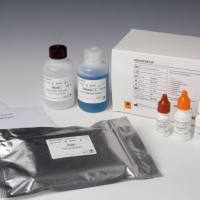植物蛋白质组学中的双向电泳技术
丁香园
2450
1. 前言
从 20 世纪 70 年代晚期以来,人们在不同的植物组织、器官、亚细胞结构和细胞器中开展了众多的寻找基因组表达差异(蛋白质组一词首次于 1994 年提出)的工作,以此来分析内部或外部刺激对蛋白表达模式的影响,如响应不同激素、化学药品或生物/非生物胁迫 (如热、冷 、干旱或臭氧),或是以此监控植物中不同生长发育阶段( 如种子萌发、成熟或衰老) [ 1~5 ] 。
除了研究由特定基因组表达产生的蛋白质组的变化外,不同基因组产生的蛋白质组的差异也被广泛的分析 [2] 。例如,根据对蛋白表达定性和定量变化的简约分析,人们评估了种群内部和种群之间的系统进化关系和遗传距离并用来建立遗传图谱和系统进化树 [6] 。另一种应用包括为了区别和鉴定关系相近的株系、品种 [7] ,杂交后代或突变体而进行的遗传多样性评估。第三个研究领域是鉴定质量相关的分子标记( 如烘培、麦芽制造和酿造质量[8] ) ,对植物病原(如真菌和病毒)的敏感性/抗性的标记和为植物育种定位数量性状基因(QTLs) [9] 。在最近的研究中,研究范围不仅扩展到对病原的研究,而且扩展到植物和共生微生物互作( 如豆科植物和固氮细菌),从食物中辨认和鉴定植物过敏原(如面粉过敏原 [10]) ( 图 13-1),或评估基因改良植物的等质同源性等方面。更加全面的总结请读者阅读这些方面的综述。
除了一些利用液相——质谱联用( LC - MS/MS) 进行的植物蛋白质组分析外,以上提到的研究中的绝大多数是基于双向电泳(2-DE) 技术。双向电泳是——并且在可预见的将来仍将是——能够被常规化应用的用以分析大规模的复杂的蛋白质混合物(如整个细胞或组织提取物)的相应蛋白表达谱的唯一分析技术。与质谱(MS) 鉴定蛋白质技术结合,双向电泳目前是蛋白质组的主要工具。双向电泳结合了等电聚焦 (IEF ) 和十二烷基硫酸钠聚丙烯酰胺电泳(SDS-PAGE ) ,根据两种不同的参数分离变性蛋白质,第一向根据等电点 (pI)第二向根据分子质量 ( Mr)。在一定的凝胶尺寸和 pH 梯度下,双向电泳可以同时分离超过 5000 个蛋白质(通常约 2000 个蛋白质),而且在使用高灵敏度蛋白质检测方法时能够定量检测 < 1 ng 的蛋白质点(图 13-1)。同样重要的是,它能得到完整蛋白质的图谱。图谱反映了蛋白质表达、异形体或翻译后修饰的变化 。与之相比,基于 LC-MS/MS 的方法分析的是肽段,不能得到蛋白质的分子质量和等电点的信息,而且进行定量分析时需要稳定的同位素标记。
最早的蛋白质组研究是由 O’ Farrell 在 1975 年报道的利用双向电泳进行的研究该研究采用载体两性电解质形成的 pH 梯度进行第一向电泳。利用固定 pH 梯度 ( IPGs) 作为第一向的双向电泳技术的引入很大程度上克服了双向电泳技术中的一些限制 [13] ,包括重复性、操作、分辨率、极酸性和(或)碱性蛋白的分离和样品载量。
IPGs 是基于两性 ImmobilineR 的应用。两性 ImmobilineR 是由 10 种有一定化学结构的丙烯酰胺衍生物组成的一系列试剂,其基本结构是 CH2=CH—CO-NH—R。其中 R 基包含一个羧基或氨基。它们形成 pK 1~13 的一系列缓冲体系。反应末端同丙烯酰胺一起聚合在凝胶结构中,这样就形成了非常稳定的 pH 梯度。在这样的梯度中能够进行真正的稳态等电聚焦并提高重复性。窄 pH 范围的 IPGs 不仅提高了分辨率(Apl =0.001),而且可以检测低丰度蛋白。同时,pH 为 12 的碱性蛋白质已经被人们利用 IPG 技术在真稳态状况下分离得到 [17] 。
其他技术方面的进步也同样为双向电泳技术在蛋白质组分析中的广泛应用做出贡献。这些进步包括:用以溶解疏水蛋白质的溶解性更强的试剂,用来半自动地平行运行多个凝胶的设备,用来提高重复性、蛋白点定量精确性和简化蛋白点比较的基于荧光染料的更加敏感的蛋白质检测方法,以及用来分析复杂双向凝胶的更加成熟的计算机软件[11] 。
一般而言,由于蛋白质理化性质和丰度的多变,蛋白质组分析在技术上比基因组分析的风险更大。例如,据估计在高等真核生物 (如植物)中超过 20000 个基因。而由于不同的蛋白质剪接、蛋白质水解、磷酸化、糖基化和百余种其他可能的翻译后修饰,这些基因能翻译成 50000~100000 种蛋白质。幸运的是,在一个特定的组织和时间里,并不是所有这些蛋白质都会表达。不过,表达蛋白质的种类很可能至少为 10000~20000。而且,植物蛋白质组分析面临一些特殊的挑战。特别是蛋白质样品制备很困难。这是因为植物坚硬的细胞壁以及中央液泡中积累的大量的干扰化合物,如酚、色素和水解酶。这些物质在组织破碎过程中会造成蛋白质的降解和(或)沉淀[ 19,20 ] 。另外,由于通常绿色植物组织中的蛋白质含量很低(一般为 2%,而哺乳动物组织或微生物细胞中大约是 20% ) ,经常需要使用富集蛋白质的方法。
尽管有上述的不利因素,2-DE-MS 已经被成功地运用到整个植物组织和亚细胞水平的蛋白质组分析中。经典的 2-DE-MS 的主要流程有:① 样品制备/预分离和蛋白质溶解;② 用双向电泳分离蛋白质;③ 蛋白质检测和定量;④ 计算机辅助分析双向电泳图谱;⑤ 质谱鉴定蛋白质;⑥ 双向蛋白质数据库构建。本文的余下部分将重点描述基于 IPGs 的双向电泳技术(方法 1 );在此其他方法将不予讨论。关于这些方面,读者可以查阅本书的相应章节和参考文献 [1]、[ 11 ] 和 [15]。
简单来说,采用了固定 pH 梯度的双向电泳技术的第一向( IEF ) 是依据 Gorg 等 [13] ;于 2000 年 [ 15 ] 和 2004 年 [11] 更新的方法,采用独立的,宽 3 mm、最长至 24 cm 的,附着在 GelBond PAGfilm 支持膜上的 IPG 胶条(实验室自制或市售 Immobiline 干胶条)进行的。样品可以通过杯上样或水化上样的方法进入胶条。IEF 完成后,IPG 胶条经含有尿素、甘油、二硫苏糖醇(DTT ) 和碘乙酰胺的 SDS 缓冲液平衡后转移至水平或垂直的 SDS 胶上进行第二向。利用半自动仪器可以在相当程度上简化双向电泳。
例如,使用 IPGphor 进行第一向,并使用多个 SDSA-PAGE 仪器可平行分离最多 20 个不同样品。电泳完成后,经分离的蛋白质通过染色的方法显示出来。染色方法包括使用硝酸银或有机染料染色,使用放射自显影(或磷光成像)显示同位素标记的样品,或最好利用荧光分子染料标记或显色 [11] 。
2. 材料
2.1 仪器
下列仪器均来自 GE Healthcare/Amersham Biosciences:
( 1 ) 等电聚焦仪(Multiphorll) 。
( 2 ) IPG 干胶条( IPG DryStrip ) 泡胀盘。
( 3 ) IPG 干胶条( IPG DryStrip ) 试剂盒。
( 4 ) IPGphor。
( 5 ) IPGphor 持胶槽。
( 6 ) IPGphor 杯上样持胶槽。
( 7 ) 多重垂直 SDS 电泳仪(Ettan DALT ) 。
( 8 ) SDS 灌胶模具。
( 9 ) 压模架。
( 10 ) 玻璃盘。
( 11 ) 循环水控温装置 (Muhitemp III ) 。
( 12 ) 电源(Multidrive XL) 。
( 13 ) 实验室用摇床。
2.2 溶液
( 1 ) 尿素裂解溶液:9.5 mol/L 尿素,2% (m/V) CHAPS,2% ( V/V) Pharmlyte pH 3~10,1% ( m/V ) DTT。
a. 配制 50 ml 裂解溶液:将 30.0 g 尿素(Merck,Darmstadt,Germany) 溶解于去离子水中,定容至 50 ml。
b. 加入 0.5 g 含有 SerdoliteMB-1 的离子交换树脂(Serva,Heidelberg,Germany);摇动 10 min,过滤。
c. 将 1.0 g CHAPS ( GE Healthcare,Freiburg,Germany) ,0.5 g DTT ( SigmaAldrich, Taufkirchen, Germany) , 1.0 ml pH 3.0~10 的 Pharmalyte ( GE Healthcare ) 和 50 mg Pefabloc 蛋白酶抑制剂(Merck) ( 用前现加)加入至 48 ml 前面配制的尿素溶液中(见注释 1 和注释 2) 。
d. 为溶解更加疏水的蛋白质,应使用硫脲/尿素解溶液 [ 2 mol/L 硫脲(SigmaAldrich) ,5~7 mol/L 尿素,2%~4% (m/V ) CHAPS 和(或)硫代甜菜碱去垢剂 ( 如 SB 3~10),1% DTT,2%(V/V)载体两性电解质 ] 配合 IPG 胶条水化液。水化液由尿素/硫脲混合物 [ 6 mol/L 尿素、2 mol/L 硫脲、1% ( m/V ) CHAPS、15 mmol/L DTT、0.5% ( V/V ) Pharmalyte,pH 3.0~10.0 ) 组成 [18] 。
( 2 ) IPG 干胶条水化液:8 mol/L 尿素、0.5%(m/V)CHAPS、15 mmol/L DTT、0.5% ( V/V ) Pharmalyte,pH 3.0~10.0。
a. 配制 50 ml 水化液:在去离子水中溶解 25.0 g 尿素(Merck) 并定容至 50 ml。
b. 加入 0.5 g Serdolite MB-1 离子交换树脂(Serva、Heidelberg、Germany) ,摇动 10 min,过滤。
c. 在 48 ml 该溶液中加入 0.25 g CHAPS ( GE Healthcare) ,0.25 ml Pharmalyte,pH 3.0~10.0,40% ( m/V) GE Healthcare 和 100 mg DTT ( Sigma- Aldrich) 并用去离子水定容至 50 ml。
( 3 ) IPG 胶条平衡液:6 mol/L 尿素,30%(m/V)甘油,2%(m/V)SDS 溶解至 0.05 mol/L pH 8.6 Tris-HCl 缓冲液中。
a. 配制 500 ml 平衡液:将 180 g 尿素(Merck) ,150 g 甘油,10 g SDS,16.7 ml SDS 凝胶缓冲液 [ 见 ⑷ ] 和 少许溴酚蓝(Serva) 。
b. 将上述试剂用去离子水溶解并定容至 500 ml。平衡液可在室温保存两周。
( 4 ) SDS 凝胶缓冲液:1.5 mol/L pH 8.6 Tris-HCl 和 0.4% ( m/V)SDS。
a. 配制 500 ml 缓冲液:将 90.85 g Trizma 碱(Sigma- Aldrich) 和 2.0 g SDS (Serva) 溶解于约 400 ml 去离子水中。
b. 用 4 mol/L HCl ( Merck) 调整 pH 至 8.6 并用去离子水定容至 500 ml。
c. 加入 50 mg 叠氮化钠(Merck) 并过滤。缓冲液可在 4°C 保存 2 周。
( 5 ) 电极缓冲液储液:配制 5 L 电极缓冲液储液:溶解 58.0 g TriZma 碱(SigmaAldrich) ,299.6 g 甘氨酸( Sigma- Aldrich) 和 19.9 g SDS (Serva) ,用去离子水定容至 5.0 L。
( 6 ) 丙烯酰胺/甲叉双丙烯酰胺溶液(30.8% T,2.6% ):30% ( m/V)丙烯酰胺和 0.8% ( m/V ) 甲叉双丙烯酰胺,由去离子水配制。
a. 配制 500 ml 溶液:溶解 150.0 g 丙烯酰胺(GE Healthcare) 和 4.0 g 甲叉双丙烯酰胺(GE Healthcare) 于去离子水中并定容至 500 ml。
b. 加入 1~2 g Serdolit MB-1 ( Serva) , 摇动 10 min,过滤。
c. 溶液可在冰箱中贮存 2 周。
( 7 ) 过硫酸铵溶液:10% ( m/V ) 过硫酸铵溶解于去离子水中。配制 10 ml 溶液:将 1.0 g 过硫酸铵(GE Health care ) 溶解于 10 ml 去离子水中。溶液应在使用前新鲜配制。
( 8 ) 指示液:50%(V/V ) 甘油和 0.01% ( m/V)溴酚蓝溶解于去离子水中。配制 500 ml 指示液:将 250 ml 甘 油(100%;Merck) 和 250 ml 去离子水混合后加入 50 mg 溴酸蓝(Serva) ,摇动数分钟。
( 9 ) 覆盖液:饱和 2-丁醇。配制 30 ml 覆盖液:将 20 ml SDS 凝胶缓冲液和 30 ml 2-丁醇(Merck) 混合,等待数分钟至两相分层,用滴管吸去丁醇层。
( 10 ) 琼脂糖溶液:在电极缓冲液中加入 0.5% (m/V ) 的琼脂糖(GE Healthcare) ,在沸水浴中熔化或用微波炉熔化。
4. 注释
( 1 ) 裂解缓冲液和 IPG 胶条水化液应当现配现用。或者分装成小份(1 ml ) 贮存于 -70°C。一旦裂解缓冲液和水化液解冻,不要再次冷冻它们。
( 2 ) 绝不要将尿素溶液加热到超过 37°C,以避免蛋白质氨基甲酰化。在添加其他药品前将尿素溶液用离子交换剂去除离子十分重要。这是因为在水溶液中尿素会转化为氰酸铵并达到平衡状态。氰酸铵可以和蛋白质侧链上的NH3+ 反应从而在双向凝胶上引起电荷现象(出现额外的蛋白点)。另外,在裂解缓冲液和水化液中一定要有载体两性电解质以除去氰酸盐。
( 3 ) 如果要用杯上样的方法向 IPG 胶条加入多于 100 μl 的样品,先加入 100 μl,然后以低电压(最大 300 V ) 进 行 IEF,直到样品转移出上样杯。接着再加入另外 100 μl,如此反复直到样品全部加入。
( 4 ) 理论上讲,从 IPG-IEF 开始到 IEF 完成这段时间里不需要进行进一步的操作。然而在实践中,如果在样品进入 IPG 胶条后用新的电极滤纸垫片更换电极和 IPG 胶条之间的电极滤纸垫片可以得到更好的结果。当样品含盐或蛋白质较多时或使用极端碱性 ( 如 IPG 6~12 或 IPG 9~12) IPG 时,这一点尤其重要。因为盐分已经快速地沿着凝胶移动并被集中于电极滤纸垫片中。遇到这些情况时,应每 2 h 更换一次滤纸垫片,如果用极端碱性的窄范围 IPG ,如 IPG 10~12,进行 IEF 时,应当每小时更换一次。
( 5 ) 当使用超过 pH 10.0 的碱性 IPG 梯度(如 IPG 6~12 或 IPG 9~12) 进行第一向时,经常会在双向蛋白质图谱的碱性端观察到水平漂移现象。用二硫化物如二硫代羟乙基 [23] 代替水化液中的 DTT 以及使用高电压(8000 V ) 以缩短电泳时间可能会解决此问题。
参考文献
1. Damerval, C., Zivy, M., Granier, F., and de Vienne, D. (1989) Two-dimensionalelectrophoresis in plant biology. Adv. Electrophoresis 2, 263-340.
2. Thiellement, H., Bahrman, N., Damerval, C., et al. (1999) Proteomics for geneticand physiological studies in plants. Electrophoresis 20, 2013-2026.
3. Thiellement, H., Zivy, M., and Plomion, C. (2002) Combining proteomic andgenetic studies in plants. J. Chromatogr. B. 782, 137-149.
4. Canovas, F. M., Dumas-Gaudot, E., Recorbet, G., Jorrin, J., Mock, H.-P., andRossignol, M. (2004) Plant proteome analysis. Proteomics 4, 285-298.
5. Bolwell, G. P., Slabas, A.R., and Whithelegge, J. P. (2004) Proteomics: empowering systems biology in plants. Phytochemistry 65, 1665-1669.
6. Posch, A., van den Berg, B., Duranton, C., and Gorg, A. (1994) Polymorphism ofpepper (Capsicum annuumL.) seed proteins studied by two-dimensional electrophoresis with immobilized pH gradients: methodical and genetic aspects. Electrophoresis 15, 297-304.
7. Gorg, A., Postel, W., Baumer, M., and Weiss, W. (1992) Two-dimensional polyacrylamide gel electrophoresis, with immobilized pH gradients in the first dimension, of barley (Hordeum vulgare L.) seed proteins: discrimination of cultivarswith different malting grades. Electrophoresis 13, 192-203.
8 . Gorg, A., Postel, W., and Weiss, W. (1992) Detection of polypeptides and amylaseisoenzyme modifications related to malting quality of barley (Hordeum vulgareL.) by 2-D electrophoresis and isoelectric focusing with immobilized pH gradients. Electrophoresis 13, 759-770.
9. Consoli, L., Lefevre, A., Zivy, M., de Vienne, D., and Damerval, C (2002) QTLanalysis of proteome and transcriptome variations for dissecting the genetic architecture of complex traits in maize. Plant Mol. Biol. 48, 575-581.
1 0 . Weiss, W., Huber, G., Engel, K. H., Pethran A., Dunn, M. J., Gooley, A.A., andGorg, A. (1997) Identification and characterization of wheat grain albumin/globu-lin allergens. Electrophoresis 1 8 , 826-833.
11. Gorg, A., Weiss, W., and Dunn, M. J. (2004) Current two-dimensional electrophoresis technology for proteomics. Proteomics 4, 3665-3685.
12 . O' Farrell, P. H. (1975) High resolution two-dimensional electrophoresis of proteins. J. Biol. Chem. 250, 400 7 02 1.
13. Gorg, A., Postel, W., and Gunther, S. (1988) The current state of two-dimensionalelectrophoresis with immobilized pH gradients. Electrophoresis 9, 531-546.
14 . Gorg, A., Obermaier, C., Boguth, G., Csordas, A., Diaz, J. J. and Madjar, J. J.
(1997) Very alkaline immobilized pH gradients for two-dimensional electrophoresis of ribosomal and nuclear proteins. Electrophoresis 1 8 , 328-337.
15. Gorg, A., Obermaier, C., Boguth, G., Harder, A., Scheibe, B., Wildgruber, R. andWeiss, W. (2000) The current state of two-dimensional electrophoresis withimmobilized pH gradients. Electrophoresis 21, 1037-1053.
16. Wildgruber, R., Reil, G., Drews, 0 ., Parlar, H. and Gorg, A. (2002) Web-basedtwo-dimensional database of Saccharomyces cerevisiaeproteins using immobilized pH gradients from pH 6 to pH 1 2 and matrix-assisted laser desorption/ioniza-tion-time of flight mass spectrometry. Proteomics 2 , 727-732.
17. Drews, O., Reil, G., Parlar, H., and Gorg, A. (2004) Setting up standards and areference map for the alkaline proteome of the Gram-positive bacteriumLactococcus lactis. Proteomics 4, 1293-1304.
18 . Rabilloud, T., Adessi, C., Giraudel, A., and Lunardi, J. (1997) Improvement of thesolubilization of proteins in two-dimensional electrophoresis with immobilized pHgradients. Electrophoresis 18 , 307-3161 9 . Hirano, H., Islam, N., and Kawasaki, H. (2004) Technical aspects of functionalproteomics in plants. Phytochemistry 65, 1487-1498.
20. Mechin, V., Consoli, L., Le Guilloux, M., and Damerval, C. (2003) An efficientsolubilization buffer for plant proteins in immobilized pH gradients. Proteomics3, 1299-1302.
21. Gorg, A. and Weiss, W. (2000) 2D electrophoresis with immobilized pH gradients,in Proteome Research: Two Dimensional Electrophoresis and Identification methods(Rabilloud, T., ed.), Springer, New York, pp. 57-106.
22. Gorg, A. and Weiss, W. (1999) Analytical IPG-Dalt. Methods Mol. Biol. 112,189-195.
23. Olsson, I., Larsson, K., Palmgren, R., and Bjellqvist, B. (2002) Organic disulfidesas a means to generate streak-free two-dimensional maps with narrow range IPGstrips as first dimension. Proteomics 2, 1630-1632.
24. Rabilloud, T., Valette, C., and Lawrence, J. J. (1994) Sample application by in-gelrehydration improves the resolution of two-dimensional electrophoresis withimmobilized pH-gradients in the first dimension. Electrophoresis15, 1552-1558.
25. Gorg, A., Boguth, G., Kopf, A., Reil, G., Parlar, H., and Weiss, W. (2002) Sampleprefractionation with Sephadex isoelectric focusing prior to narrow pH range two-dimensional gels. Proteomics 2, 165 2-1657.
26. Gorg, A., Postel, W., Friedrich, C., Kuick, R., Strahler, J. R., and Hanash, S. M.
(1991) Temperature-dependent spot positional variability in two-dimensionalpolypeptide patterns. Electrophoresis12,653-658.
27. Islam, R., Ko, C., and Landers, T. (1998) A new approach to rapid immobilised pHgradient IEF for 2-D electrophoresis. Science Tools3, 14-15.
28. Gorg, A., Obermaier, C., Boguth, G., and Weiss, W. (1999) Recent developmentsin 2-D gel electrophoresis with immobilized pH gradients: wide pH gradients up topH 1 2 , longer separation distances and simplified procedures. Electrophoresis 20,712-717.
29. Gorg, A., Boguth, G., Obermaier, C., Posch, A., and Weiss, W. (1995) Two-dimensional polyacrylamide gel electrophoresis with immobilized pH gradients inthe first dimension (IPG-Dalt): the state of the art and the controversy of verticalversus horizontal systems. Electrophoresis16, 1079-1086.
30. Gorg, A. and Weiss, W. (1999) Horizontal SDS-PAGE for IPG-Dalt. Methods Mol.Biol.112, 235-244.
31. Anderson, N. L. and Anderson, N. G. (1978) Analytical techniques for cell fractions: multiple gradient-slab gel electrophoresis. Anal. Biochem. 85, 341-354.
32. Posch, A., Weiss, W., Wheeler, C., Dunn, M. J., and Gorg, A. (1995) Sequenceanalysis of wheat grain allergens separated by 2-D electrophoresis with immobilized pH gradients. Electrophoresis16, 1115-1119.
33. Westermeier, R. and Gorg, A. (2005) in: Protein Purification,3rd ed., (Janson, J.C., ed.), John Wiley & Sons, New York.
从 20 世纪 70 年代晚期以来,人们在不同的植物组织、器官、亚细胞结构和细胞器中开展了众多的寻找基因组表达差异(蛋白质组一词首次于 1994 年提出)的工作,以此来分析内部或外部刺激对蛋白表达模式的影响,如响应不同激素、化学药品或生物/非生物胁迫 (如热、冷 、干旱或臭氧),或是以此监控植物中不同生长发育阶段( 如种子萌发、成熟或衰老) [ 1~5 ] 。
除了研究由特定基因组表达产生的蛋白质组的变化外,不同基因组产生的蛋白质组的差异也被广泛的分析 [2] 。例如,根据对蛋白表达定性和定量变化的简约分析,人们评估了种群内部和种群之间的系统进化关系和遗传距离并用来建立遗传图谱和系统进化树 [6] 。另一种应用包括为了区别和鉴定关系相近的株系、品种 [7] ,杂交后代或突变体而进行的遗传多样性评估。第三个研究领域是鉴定质量相关的分子标记( 如烘培、麦芽制造和酿造质量[8] ) ,对植物病原(如真菌和病毒)的敏感性/抗性的标记和为植物育种定位数量性状基因(QTLs) [9] 。在最近的研究中,研究范围不仅扩展到对病原的研究,而且扩展到植物和共生微生物互作( 如豆科植物和固氮细菌),从食物中辨认和鉴定植物过敏原(如面粉过敏原 [10]) ( 图 13-1),或评估基因改良植物的等质同源性等方面。更加全面的总结请读者阅读这些方面的综述。
除了一些利用液相——质谱联用( LC - MS/MS) 进行的植物蛋白质组分析外,以上提到的研究中的绝大多数是基于双向电泳(2-DE) 技术。双向电泳是——并且在可预见的将来仍将是——能够被常规化应用的用以分析大规模的复杂的蛋白质混合物(如整个细胞或组织提取物)的相应蛋白表达谱的唯一分析技术。与质谱(MS) 鉴定蛋白质技术结合,双向电泳目前是蛋白质组的主要工具。双向电泳结合了等电聚焦 (IEF ) 和十二烷基硫酸钠聚丙烯酰胺电泳(SDS-PAGE ) ,根据两种不同的参数分离变性蛋白质,第一向根据等电点 (pI)第二向根据分子质量 ( Mr)。在一定的凝胶尺寸和 pH 梯度下,双向电泳可以同时分离超过 5000 个蛋白质(通常约 2000 个蛋白质),而且在使用高灵敏度蛋白质检测方法时能够定量检测 < 1 ng 的蛋白质点(图 13-1)。同样重要的是,它能得到完整蛋白质的图谱。图谱反映了蛋白质表达、异形体或翻译后修饰的变化 。与之相比,基于 LC-MS/MS 的方法分析的是肽段,不能得到蛋白质的分子质量和等电点的信息,而且进行定量分析时需要稳定的同位素标记。
最早的蛋白质组研究是由 O’ Farrell 在 1975 年报道的利用双向电泳进行的研究该研究采用载体两性电解质形成的 pH 梯度进行第一向电泳。利用固定 pH 梯度 ( IPGs) 作为第一向的双向电泳技术的引入很大程度上克服了双向电泳技术中的一些限制 [13] ,包括重复性、操作、分辨率、极酸性和(或)碱性蛋白的分离和样品载量。
IPGs 是基于两性 ImmobilineR 的应用。两性 ImmobilineR 是由 10 种有一定化学结构的丙烯酰胺衍生物组成的一系列试剂,其基本结构是 CH2=CH—CO-NH—R。其中 R 基包含一个羧基或氨基。它们形成 pK 1~13 的一系列缓冲体系。反应末端同丙烯酰胺一起聚合在凝胶结构中,这样就形成了非常稳定的 pH 梯度。在这样的梯度中能够进行真正的稳态等电聚焦并提高重复性。窄 pH 范围的 IPGs 不仅提高了分辨率(Apl =0.001),而且可以检测低丰度蛋白。同时,pH 为 12 的碱性蛋白质已经被人们利用 IPG 技术在真稳态状况下分离得到 [17] 。
其他技术方面的进步也同样为双向电泳技术在蛋白质组分析中的广泛应用做出贡献。这些进步包括:用以溶解疏水蛋白质的溶解性更强的试剂,用来半自动地平行运行多个凝胶的设备,用来提高重复性、蛋白点定量精确性和简化蛋白点比较的基于荧光染料的更加敏感的蛋白质检测方法,以及用来分析复杂双向凝胶的更加成熟的计算机软件[11] 。
一般而言,由于蛋白质理化性质和丰度的多变,蛋白质组分析在技术上比基因组分析的风险更大。例如,据估计在高等真核生物 (如植物)中超过 20000 个基因。而由于不同的蛋白质剪接、蛋白质水解、磷酸化、糖基化和百余种其他可能的翻译后修饰,这些基因能翻译成 50000~100000 种蛋白质。幸运的是,在一个特定的组织和时间里,并不是所有这些蛋白质都会表达。不过,表达蛋白质的种类很可能至少为 10000~20000。而且,植物蛋白质组分析面临一些特殊的挑战。特别是蛋白质样品制备很困难。这是因为植物坚硬的细胞壁以及中央液泡中积累的大量的干扰化合物,如酚、色素和水解酶。这些物质在组织破碎过程中会造成蛋白质的降解和(或)沉淀[ 19,20 ] 。另外,由于通常绿色植物组织中的蛋白质含量很低(一般为 2%,而哺乳动物组织或微生物细胞中大约是 20% ) ,经常需要使用富集蛋白质的方法。
尽管有上述的不利因素,2-DE-MS 已经被成功地运用到整个植物组织和亚细胞水平的蛋白质组分析中。经典的 2-DE-MS 的主要流程有:① 样品制备/预分离和蛋白质溶解;② 用双向电泳分离蛋白质;③ 蛋白质检测和定量;④ 计算机辅助分析双向电泳图谱;⑤ 质谱鉴定蛋白质;⑥ 双向蛋白质数据库构建。本文的余下部分将重点描述基于 IPGs 的双向电泳技术(方法 1 );在此其他方法将不予讨论。关于这些方面,读者可以查阅本书的相应章节和参考文献 [1]、[ 11 ] 和 [15]。
简单来说,采用了固定 pH 梯度的双向电泳技术的第一向( IEF ) 是依据 Gorg 等 [13] ;于 2000 年 [ 15 ] 和 2004 年 [11] 更新的方法,采用独立的,宽 3 mm、最长至 24 cm 的,附着在 GelBond PAGfilm 支持膜上的 IPG 胶条(实验室自制或市售 Immobiline 干胶条)进行的。样品可以通过杯上样或水化上样的方法进入胶条。IEF 完成后,IPG 胶条经含有尿素、甘油、二硫苏糖醇(DTT ) 和碘乙酰胺的 SDS 缓冲液平衡后转移至水平或垂直的 SDS 胶上进行第二向。利用半自动仪器可以在相当程度上简化双向电泳。
例如,使用 IPGphor 进行第一向,并使用多个 SDSA-PAGE 仪器可平行分离最多 20 个不同样品。电泳完成后,经分离的蛋白质通过染色的方法显示出来。染色方法包括使用硝酸银或有机染料染色,使用放射自显影(或磷光成像)显示同位素标记的样品,或最好利用荧光分子染料标记或显色 [11] 。
2. 材料
2.1 仪器
下列仪器均来自 GE Healthcare/Amersham Biosciences:
( 1 ) 等电聚焦仪(Multiphorll) 。
( 2 ) IPG 干胶条( IPG DryStrip ) 泡胀盘。
( 3 ) IPG 干胶条( IPG DryStrip ) 试剂盒。
( 4 ) IPGphor。
( 5 ) IPGphor 持胶槽。
( 6 ) IPGphor 杯上样持胶槽。
( 7 ) 多重垂直 SDS 电泳仪(Ettan DALT ) 。
( 8 ) SDS 灌胶模具。
( 9 ) 压模架。
( 10 ) 玻璃盘。
( 11 ) 循环水控温装置 (Muhitemp III ) 。
( 12 ) 电源(Multidrive XL) 。
( 13 ) 实验室用摇床。
2.2 溶液
( 1 ) 尿素裂解溶液:9.5 mol/L 尿素,2% (m/V) CHAPS,2% ( V/V) Pharmlyte pH 3~10,1% ( m/V ) DTT。
a. 配制 50 ml 裂解溶液:将 30.0 g 尿素(Merck,Darmstadt,Germany) 溶解于去离子水中,定容至 50 ml。
b. 加入 0.5 g 含有 SerdoliteMB-1 的离子交换树脂(Serva,Heidelberg,Germany);摇动 10 min,过滤。
c. 将 1.0 g CHAPS ( GE Healthcare,Freiburg,Germany) ,0.5 g DTT ( SigmaAldrich, Taufkirchen, Germany) , 1.0 ml pH 3.0~10 的 Pharmalyte ( GE Healthcare ) 和 50 mg Pefabloc 蛋白酶抑制剂(Merck) ( 用前现加)加入至 48 ml 前面配制的尿素溶液中(见注释 1 和注释 2) 。
d. 为溶解更加疏水的蛋白质,应使用硫脲/尿素解溶液 [ 2 mol/L 硫脲(SigmaAldrich) ,5~7 mol/L 尿素,2%~4% (m/V ) CHAPS 和(或)硫代甜菜碱去垢剂 ( 如 SB 3~10),1% DTT,2%(V/V)载体两性电解质 ] 配合 IPG 胶条水化液。水化液由尿素/硫脲混合物 [ 6 mol/L 尿素、2 mol/L 硫脲、1% ( m/V ) CHAPS、15 mmol/L DTT、0.5% ( V/V ) Pharmalyte,pH 3.0~10.0 ) 组成 [18] 。
( 2 ) IPG 干胶条水化液:8 mol/L 尿素、0.5%(m/V)CHAPS、15 mmol/L DTT、0.5% ( V/V ) Pharmalyte,pH 3.0~10.0。
a. 配制 50 ml 水化液:在去离子水中溶解 25.0 g 尿素(Merck) 并定容至 50 ml。
b. 加入 0.5 g Serdolite MB-1 离子交换树脂(Serva、Heidelberg、Germany) ,摇动 10 min,过滤。
c. 在 48 ml 该溶液中加入 0.25 g CHAPS ( GE Healthcare) ,0.25 ml Pharmalyte,pH 3.0~10.0,40% ( m/V) GE Healthcare 和 100 mg DTT ( Sigma- Aldrich) 并用去离子水定容至 50 ml。
( 3 ) IPG 胶条平衡液:6 mol/L 尿素,30%(m/V)甘油,2%(m/V)SDS 溶解至 0.05 mol/L pH 8.6 Tris-HCl 缓冲液中。
a. 配制 500 ml 平衡液:将 180 g 尿素(Merck) ,150 g 甘油,10 g SDS,16.7 ml SDS 凝胶缓冲液 [ 见 ⑷ ] 和 少许溴酚蓝(Serva) 。
b. 将上述试剂用去离子水溶解并定容至 500 ml。平衡液可在室温保存两周。
( 4 ) SDS 凝胶缓冲液:1.5 mol/L pH 8.6 Tris-HCl 和 0.4% ( m/V)SDS。
a. 配制 500 ml 缓冲液:将 90.85 g Trizma 碱(Sigma- Aldrich) 和 2.0 g SDS (Serva) 溶解于约 400 ml 去离子水中。
b. 用 4 mol/L HCl ( Merck) 调整 pH 至 8.6 并用去离子水定容至 500 ml。
c. 加入 50 mg 叠氮化钠(Merck) 并过滤。缓冲液可在 4°C 保存 2 周。
( 5 ) 电极缓冲液储液:配制 5 L 电极缓冲液储液:溶解 58.0 g TriZma 碱(SigmaAldrich) ,299.6 g 甘氨酸( Sigma- Aldrich) 和 19.9 g SDS (Serva) ,用去离子水定容至 5.0 L。
( 6 ) 丙烯酰胺/甲叉双丙烯酰胺溶液(30.8% T,2.6% ):30% ( m/V)丙烯酰胺和 0.8% ( m/V ) 甲叉双丙烯酰胺,由去离子水配制。
a. 配制 500 ml 溶液:溶解 150.0 g 丙烯酰胺(GE Healthcare) 和 4.0 g 甲叉双丙烯酰胺(GE Healthcare) 于去离子水中并定容至 500 ml。
b. 加入 1~2 g Serdolit MB-1 ( Serva) , 摇动 10 min,过滤。
c. 溶液可在冰箱中贮存 2 周。
( 7 ) 过硫酸铵溶液:10% ( m/V ) 过硫酸铵溶解于去离子水中。配制 10 ml 溶液:将 1.0 g 过硫酸铵(GE Health care ) 溶解于 10 ml 去离子水中。溶液应在使用前新鲜配制。
( 8 ) 指示液:50%(V/V ) 甘油和 0.01% ( m/V)溴酚蓝溶解于去离子水中。配制 500 ml 指示液:将 250 ml 甘 油(100%;Merck) 和 250 ml 去离子水混合后加入 50 mg 溴酸蓝(Serva) ,摇动数分钟。
( 9 ) 覆盖液:饱和 2-丁醇。配制 30 ml 覆盖液:将 20 ml SDS 凝胶缓冲液和 30 ml 2-丁醇(Merck) 混合,等待数分钟至两相分层,用滴管吸去丁醇层。
( 10 ) 琼脂糖溶液:在电极缓冲液中加入 0.5% (m/V ) 的琼脂糖(GE Healthcare) ,在沸水浴中熔化或用微波炉熔化。
4. 注释
( 1 ) 裂解缓冲液和 IPG 胶条水化液应当现配现用。或者分装成小份(1 ml ) 贮存于 -70°C。一旦裂解缓冲液和水化液解冻,不要再次冷冻它们。
( 2 ) 绝不要将尿素溶液加热到超过 37°C,以避免蛋白质氨基甲酰化。在添加其他药品前将尿素溶液用离子交换剂去除离子十分重要。这是因为在水溶液中尿素会转化为氰酸铵并达到平衡状态。氰酸铵可以和蛋白质侧链上的NH3+ 反应从而在双向凝胶上引起电荷现象(出现额外的蛋白点)。另外,在裂解缓冲液和水化液中一定要有载体两性电解质以除去氰酸盐。
( 3 ) 如果要用杯上样的方法向 IPG 胶条加入多于 100 μl 的样品,先加入 100 μl,然后以低电压(最大 300 V ) 进 行 IEF,直到样品转移出上样杯。接着再加入另外 100 μl,如此反复直到样品全部加入。
( 4 ) 理论上讲,从 IPG-IEF 开始到 IEF 完成这段时间里不需要进行进一步的操作。然而在实践中,如果在样品进入 IPG 胶条后用新的电极滤纸垫片更换电极和 IPG 胶条之间的电极滤纸垫片可以得到更好的结果。当样品含盐或蛋白质较多时或使用极端碱性 ( 如 IPG 6~12 或 IPG 9~12) IPG 时,这一点尤其重要。因为盐分已经快速地沿着凝胶移动并被集中于电极滤纸垫片中。遇到这些情况时,应每 2 h 更换一次滤纸垫片,如果用极端碱性的窄范围 IPG ,如 IPG 10~12,进行 IEF 时,应当每小时更换一次。
( 5 ) 当使用超过 pH 10.0 的碱性 IPG 梯度(如 IPG 6~12 或 IPG 9~12) 进行第一向时,经常会在双向蛋白质图谱的碱性端观察到水平漂移现象。用二硫化物如二硫代羟乙基 [23] 代替水化液中的 DTT 以及使用高电压(8000 V ) 以缩短电泳时间可能会解决此问题。
参考文献
1. Damerval, C., Zivy, M., Granier, F., and de Vienne, D. (1989) Two-dimensionalelectrophoresis in plant biology. Adv. Electrophoresis 2, 263-340.
2. Thiellement, H., Bahrman, N., Damerval, C., et al. (1999) Proteomics for geneticand physiological studies in plants. Electrophoresis 20, 2013-2026.
3. Thiellement, H., Zivy, M., and Plomion, C. (2002) Combining proteomic andgenetic studies in plants. J. Chromatogr. B. 782, 137-149.
4. Canovas, F. M., Dumas-Gaudot, E., Recorbet, G., Jorrin, J., Mock, H.-P., andRossignol, M. (2004) Plant proteome analysis. Proteomics 4, 285-298.
5. Bolwell, G. P., Slabas, A.R., and Whithelegge, J. P. (2004) Proteomics: empowering systems biology in plants. Phytochemistry 65, 1665-1669.
6. Posch, A., van den Berg, B., Duranton, C., and Gorg, A. (1994) Polymorphism ofpepper (Capsicum annuumL.) seed proteins studied by two-dimensional electrophoresis with immobilized pH gradients: methodical and genetic aspects. Electrophoresis 15, 297-304.
7. Gorg, A., Postel, W., Baumer, M., and Weiss, W. (1992) Two-dimensional polyacrylamide gel electrophoresis, with immobilized pH gradients in the first dimension, of barley (Hordeum vulgare L.) seed proteins: discrimination of cultivarswith different malting grades. Electrophoresis 13, 192-203.
8 . Gorg, A., Postel, W., and Weiss, W. (1992) Detection of polypeptides and amylaseisoenzyme modifications related to malting quality of barley (Hordeum vulgareL.) by 2-D electrophoresis and isoelectric focusing with immobilized pH gradients. Electrophoresis 13, 759-770.
9. Consoli, L., Lefevre, A., Zivy, M., de Vienne, D., and Damerval, C (2002) QTLanalysis of proteome and transcriptome variations for dissecting the genetic architecture of complex traits in maize. Plant Mol. Biol. 48, 575-581.
1 0 . Weiss, W., Huber, G., Engel, K. H., Pethran A., Dunn, M. J., Gooley, A.A., andGorg, A. (1997) Identification and characterization of wheat grain albumin/globu-lin allergens. Electrophoresis 1 8 , 826-833.
11. Gorg, A., Weiss, W., and Dunn, M. J. (2004) Current two-dimensional electrophoresis technology for proteomics. Proteomics 4, 3665-3685.
12 . O' Farrell, P. H. (1975) High resolution two-dimensional electrophoresis of proteins. J. Biol. Chem. 250, 400 7 02 1.
13. Gorg, A., Postel, W., and Gunther, S. (1988) The current state of two-dimensionalelectrophoresis with immobilized pH gradients. Electrophoresis 9, 531-546.
14 . Gorg, A., Obermaier, C., Boguth, G., Csordas, A., Diaz, J. J. and Madjar, J. J.
(1997) Very alkaline immobilized pH gradients for two-dimensional electrophoresis of ribosomal and nuclear proteins. Electrophoresis 1 8 , 328-337.
15. Gorg, A., Obermaier, C., Boguth, G., Harder, A., Scheibe, B., Wildgruber, R. andWeiss, W. (2000) The current state of two-dimensional electrophoresis withimmobilized pH gradients. Electrophoresis 21, 1037-1053.
16. Wildgruber, R., Reil, G., Drews, 0 ., Parlar, H. and Gorg, A. (2002) Web-basedtwo-dimensional database of Saccharomyces cerevisiaeproteins using immobilized pH gradients from pH 6 to pH 1 2 and matrix-assisted laser desorption/ioniza-tion-time of flight mass spectrometry. Proteomics 2 , 727-732.
17. Drews, O., Reil, G., Parlar, H., and Gorg, A. (2004) Setting up standards and areference map for the alkaline proteome of the Gram-positive bacteriumLactococcus lactis. Proteomics 4, 1293-1304.
18 . Rabilloud, T., Adessi, C., Giraudel, A., and Lunardi, J. (1997) Improvement of thesolubilization of proteins in two-dimensional electrophoresis with immobilized pHgradients. Electrophoresis 18 , 307-3161 9 . Hirano, H., Islam, N., and Kawasaki, H. (2004) Technical aspects of functionalproteomics in plants. Phytochemistry 65, 1487-1498.
20. Mechin, V., Consoli, L., Le Guilloux, M., and Damerval, C. (2003) An efficientsolubilization buffer for plant proteins in immobilized pH gradients. Proteomics3, 1299-1302.
21. Gorg, A. and Weiss, W. (2000) 2D electrophoresis with immobilized pH gradients,in Proteome Research: Two Dimensional Electrophoresis and Identification methods(Rabilloud, T., ed.), Springer, New York, pp. 57-106.
22. Gorg, A. and Weiss, W. (1999) Analytical IPG-Dalt. Methods Mol. Biol. 112,189-195.
23. Olsson, I., Larsson, K., Palmgren, R., and Bjellqvist, B. (2002) Organic disulfidesas a means to generate streak-free two-dimensional maps with narrow range IPGstrips as first dimension. Proteomics 2, 1630-1632.
24. Rabilloud, T., Valette, C., and Lawrence, J. J. (1994) Sample application by in-gelrehydration improves the resolution of two-dimensional electrophoresis withimmobilized pH-gradients in the first dimension. Electrophoresis15, 1552-1558.
25. Gorg, A., Boguth, G., Kopf, A., Reil, G., Parlar, H., and Weiss, W. (2002) Sampleprefractionation with Sephadex isoelectric focusing prior to narrow pH range two-dimensional gels. Proteomics 2, 165 2-1657.
26. Gorg, A., Postel, W., Friedrich, C., Kuick, R., Strahler, J. R., and Hanash, S. M.
(1991) Temperature-dependent spot positional variability in two-dimensionalpolypeptide patterns. Electrophoresis12,653-658.
27. Islam, R., Ko, C., and Landers, T. (1998) A new approach to rapid immobilised pHgradient IEF for 2-D electrophoresis. Science Tools3, 14-15.
28. Gorg, A., Obermaier, C., Boguth, G., and Weiss, W. (1999) Recent developmentsin 2-D gel electrophoresis with immobilized pH gradients: wide pH gradients up topH 1 2 , longer separation distances and simplified procedures. Electrophoresis 20,712-717.
29. Gorg, A., Boguth, G., Obermaier, C., Posch, A., and Weiss, W. (1995) Two-dimensional polyacrylamide gel electrophoresis with immobilized pH gradients inthe first dimension (IPG-Dalt): the state of the art and the controversy of verticalversus horizontal systems. Electrophoresis16, 1079-1086.
30. Gorg, A. and Weiss, W. (1999) Horizontal SDS-PAGE for IPG-Dalt. Methods Mol.Biol.112, 235-244.
31. Anderson, N. L. and Anderson, N. G. (1978) Analytical techniques for cell fractions: multiple gradient-slab gel electrophoresis. Anal. Biochem. 85, 341-354.
32. Posch, A., Weiss, W., Wheeler, C., Dunn, M. J., and Gorg, A. (1995) Sequenceanalysis of wheat grain allergens separated by 2-D electrophoresis with immobilized pH gradients. Electrophoresis16, 1115-1119.
33. Westermeier, R. and Gorg, A. (2005) in: Protein Purification,3rd ed., (Janson, J.C., ed.), John Wiley & Sons, New York.







